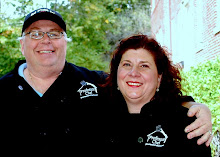
We helped a neighbor make his first batch of beer some grain was used in the brewing process so we thought we would attempt to make a Spent Grain bread. The recipe is adapted from Peter Reinhart's Whole Grain Breads book (if you like whole grain bread, this book is great!). It takes two days, but it is worth the wait. It uses 'spent grain’, which is the grains that are left over from brewing beer. In the home brewing process, these grains were steeped for about a half hour in boiling water. The taste, texture, and color of the bread will vary considerably with the type of grain used for the beer there will be a big difference between a stout and pale ale grains, our bread was made with pale ale grain. If you're not a home brewer try asking your friends or you could also ask a local microbrewery.
This recipe makes two medium or 4 small loaves, or about two dozen rolls.
Day 1:
About 20 minutes of work.
Soaker
The soaker works to hydrate the grains in the whole wheat by mixing it with water and salt and let it sit overnight. This makes the grain softer but also enhances flavor and makes the bread a little sweeter (check Reinhart's book for the whole explanation).
Ingredients:
• 454 g / 1 lb whole wheat flour
• 1 tsp (8 g) salt
• 1½ cups water
Mix all soaker ingredients until flour is fully hydrated, then cover and let sit at room temperature for 12-24 hours. Can be refrigerated up to 3 days.
Biga
Reinhart uses the term 'Biga' for an overnight starter that uses a small amount of yeast and also soaks the whole wheat flour to increase flavor and acidity.
Ingredients:
• 454 g / 1 lb whole wheat flour
• 5/8 tsp active dry yeast (1/2 tsp instant dry yeast)
• 1½ cups warm water
Make a well in the flour. Pour the water into the well and then sprinkle the yeast in the water. Mix the water, gradually drawing in all the flour until hydrated. Once you have a ball of dough, knead in the bowl using wet hands for about two minutes. You may need to wet your hands again, but be careful not to add too much water to the dough.
Let the dough rest for five minutes, and then knead again with wet hands for about one minute. This time, the dough will be easier to work with, although it will still be tacky. Cover and refrigerate for at least 8 hours.
Day 2:
About 2 hours de-chill, then 20 minutes mixing followed by 2-3 hours fermentation. Baking takes 45-60 minutes.
Now we make the bread. Remove the Biga from the refrigerator about two hours before starting to mix the final dough.
Ingredients:
• Soaker
• Biga
• 225 g spent grain
• 113 g whole wheat flour
• 2¼ tsp (10 g) salt
• 2 Tbsp + 1 tsp active dry yeast (1½ Tbsp instant dry yeast)
• 85 g (4½ Tbsp) honey
• 2 Tbsp vegetable oil (optional)
• Extra whole wheat flour for adjustments
Chop the soaker and biga into 10-12 smaller pieces each - sprinkle some extra flour to keep them from sticking to each other. Hydrate the yeast in a little warm water (just enough to form a thick paste). Add to biga and soaker pieces along with the remaining ingredients except extra flour. Mix with a spoon or knead with wet hands for a few minutes to evenly distribute all ingredients. Take the dough out onto a lightly floured surface. Knead for 3-4 minutes until dough is soft and tacky but not sticky. Form the dough into a ball and let it rest on the counter for five minutes.
Knead the dough again for about a minute. The dough should feel soft, supple, and very tacky. Place the dough into a lightly oiled bowl, covering it in oil on all sides. Cover the bowl and let the dough rise at room temperature for 45 to 60 minutes.
Form the dough into two loaves or smaller rolls. Cover loosely and let rise an additional 45 to 60 minutes.
IN A COVENTIONAL OVEN: Preheat oven to 425F. Add a steam pan to the oven and a hearth stone. When you put the bread into the oven, pour a cup of water into the steam pan and spray several times with a water mister inside the oven (not on the bread). The purpose is to create steam that will produce a crusty crumb on the bread. Lower the temperature to 350F and bake for 20 minutes. Rotate the bread 180°and bake another 20-30 minutes until the bread is done (thump the bottom to hear if it sounds hollow).
IN A BRICK OVEN: Heat oven to about 500F have a cast iron fry pan heating in the oven. Take out coals and cast iron pan and brush off hearth surface. Put pan back in oven and pour heated water in pan to create steam. Place the loves of bread in oven. Spray inside of oven with a misting spray bottle Close oven check after one half hour you may need to let the loaves stay in for another 15 minuets or so (thump the bottom to hear if it sounds hollow).
Cool on a wire rack and enjoy! Leave a comment if you try it out and let us know how it went.
SEE THE WHOLE PROCESS IN PICTURES..CLICK ON THE PHOTO BELOW TO SEE THE ALBUM
 |
| Spent Grain Bread |












